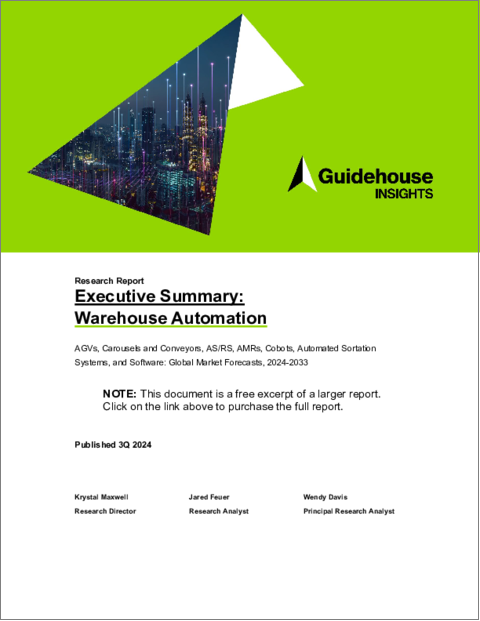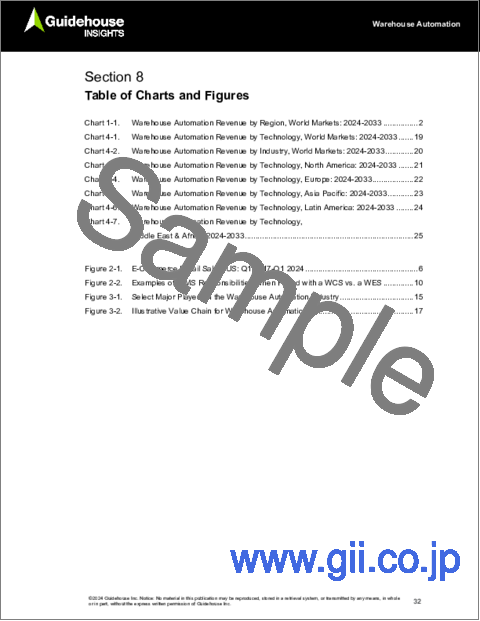|
|
市場調査レポート
商品コード
1524071
ウェアハウスオートメーション - AGV、カルーセル・コンベア、AS/RS、AMR、コボット、自動仕分けシステム、ソフトウェア:世界市場の予測 (2024~2033年)Warehouse Automation - AGVs, Carousels and Conveyors, AS/RS, AMRs, Cobots, Automated Sortation Systems, and Software: Global Market Forecasts, 2024-2033 |
||||||
|
|||||||
| ウェアハウスオートメーション - AGV、カルーセル・コンベア、AS/RS、AMR、コボット、自動仕分けシステム、ソフトウェア:世界市場の予測 (2024~2033年) |
|
出版日: 2024年07月31日
発行: Guidehouse Research
ページ情報: 英文 35 Pages; 25 Tables, Charts & Figures
納期: 即納可能
|
全表示
- 概要
- 図表
- 目次
COVID-19パンデミック以来、消費者の購買習慣が倉庫業界に、より速いスピードで製品を生産するように圧力を強めています。倉庫を所有する企業や倉庫を通じて出荷する企業は、消費者の期待に応えるため、夜間出荷や当日出荷を当たり前にしてきました。このような需要を満たすだけでなく、倉庫業務の効率と精度を高めるためにも、倉庫業界は反復的で骨の折れるプロセスの自動化に乗り出しています。このことが、倉庫自動化産業の全体的な成長につながっています。
しかし、倉庫自動化技術の市場はまだ初期段階あり、幅広い普及が見込まれるまでには、数多くの課題を克服しなければなりません。倉庫自動化の統合によるメリットに対する認識は低い一方、各種の自動化技術の導入コストは高いため、人間の労働力が安価な地域では、これらの技術はROIの点で割に合わないかもしれません。さらに、倉庫自動化技術はここ数年で改善されたとはいえ、倉庫スペース内で人間がこれらの技術といかにうまく連携しコミュニケーションが取れるか、という点ではまだギャップがあります。
当レポートでは、世界の倉庫自動化の市場について、7つの技術分野別 (無人搬送車 (AGV)、カルーセル・コンベア、自動保管・検索システム (AS/RS)、自律移動ロボット (AMR)、協働ロボット (コボット)、自動仕分けシステム、ソフトウェア) に分析しております。また、市場の促進要因と抑制要因について考察し、倉庫自動化技術の普及浸透のための業界利害関係者への提言を掲載しています。さらに、今後の市場収益の動向見通し (2033年まで) を、技術別・地域別 (北米、欧州、アジア太平洋、ラテンアメリカ、中東・アフリカ)・産業別 (小売、医療・医薬品、輸送、食品・飲料、エレクトロニクス、その他) に予測しています。
目次
第1章 エグゼクティブサマリー
第2章 市場の問題点
- 技術
- 無人搬送車 (AGV)
- カルーセル・コンベア
- 自動保管・検索システム (自動倉庫、AS/RS)
- 自律移動ロボット
- 協働ロボット
- 自動仕分けシステム
- ソフトウェア
- 促進要因
- 倉庫の生産性の向上
- ヒューマンエラーの抑制と精度の向上
- 倉庫での怪我の減少
- 人件費の削減
- スケーラビリティの向上
- 抑制要因
- 技術コスト
- 整備と停止時間
- 既存システムとの統合と通信の制限
- 倉庫自動化に対する従業員の反対
- 商品の包装
- 価格
第3章 業界情勢
- 競合情勢
- 産業バリューチェーン
第4章 市場予測
- 世界市場の予測:技術別
- 世界市場の予測:業界別
- 各地域の市場予測:技術別
- 北米
- 欧州
- アジア太平洋
- ラテンアメリカ
- 中東・アフリカ
第5章 結論・提言
- 3つの大きなポイント
- 提言
- 倉庫自動化プロバイダー
- 倉庫に保管されている製品の製造業者
- 倉庫所有者および運営者
第6章 頭字語と略語一覧
第7章 目次
第8章 図表
第9章 調査範囲
第10章 情報源・調査手法・注釈
List of Tables
- Warehouse Automation Revenue by Region, World Markets: 2024-2033
- Warehouse Automation Revenue by Technology, World Markets: 2024-2033
- Warehouse Automation Revenue by Industry, World Markets: 2024-2033
- Warehouse Automation Revenue by Technology, North America: 2024-2033
- Warehouse Automation Revenue by Technology, Europe: 2024-2033
- Warehouse Automation Revenue by Technology, Asia Pacific: 2024-2033
- Warehouse Automation Revenue by Technology, Latin America: 2024-2033
- Warehouse Automation Revenue by Technology, Middle East & Africa: 2024-2033
- Warehouse Automation Revenue by Industry, North America: 2024-2033
- Warehouse Automation Revenue by Industry, Europe: 2024-2033
- Warehouse Automation Revenue by Industry, Asia Pacific: 2024-2033
- Warehouse Automation Revenue by Industry, Latin America: 2024-2033
- Warehouse Automation Revenue by Industry, Middle East & Africa: 2024-2033
List of Figures
- Warehouse Automation Revenue by Region, World Markets: 2024-2033
- Warehouse Automation Revenue by Technology, World Markets: 2024-2033
- Warehouse Automation Revenue by Industry, World Markets: 2024-2033
- Warehouse Automation Revenue by Technology, North America: 2024-2033
- Warehouse Automation Revenue by Technology, Europe: 2024-2033
- Warehouse Automation Revenue by Technology, Asia Pacific: 2024-2033
- Warehouse Automation Revenue by Technology, Latin America: 2024-2033
- Warehouse Automation Revenue by Technology, Middle East & Africa: 2024-2033
E-Commerce Retail Sales, US: Q1 2017-Q1 2024
Examples of WMS Responsibilities When Paired with a WCS vs. a WES
Select Major Players in the Warehouse Automation Industry
Illustrative Value Chain for Warehouse Automation
Since the COVID-19 pandemic, consumer purchasing habits have placed increased pressure on the warehouse industry to churn out products at a faster rate. Companies that own warehouses or ship through warehouses have made overnight and 1-day shipping commonplace to meet consumer expectations. To satisfy these demands as well as increase the efficiency and accuracy of warehouse operations, warehouses have increasingly started automating repetitive and strenuous processes. This has led to overall growth in the warehouse automation industry.
However, the market for warehouse automation technologies is nascent, and numerous challenges must be overcome before widespread adoption can be expected. Awareness of the benefits of integrating warehouse automation is low, the cost of implementing many of the automation technologies is high, and the ROI for these technologies may not be worthwhile in regions where human labor is cheap. Further, while warehouse automation technologies have improved over the last few years, there are still gaps in how well humans can collaborate and communicate with these technologies within the warehouse space.
This Guidehouse Insights report analyzes the global market for warehouse automation for seven technologies: autonomous guided vehicles (AGVs), carousels and conveyors, automated storage and retrieval systems (AS/RS), autonomous mobile robots (AMRs), collaborative robots (cobots), automated sortation systems, and software. The report discusses market drivers and barriers and issues recommendations to industry stakeholders for increasing the adoption of warehouse automation technologies. Revenue forecasts through 2033 are segmented by technology, global region (North America, Europe, Asia Pacific, Latin America, Middle East & Africa), and industry (retail, health and pharmaceuticals, transportation, food and beverage, electronics, other).
Table of Contents
1. Executive Summary
- 1.1 Introduction
- 1.1.1 Scope
- 1.1.2 Market Drivers
- 1.1.3 Market Barriers
- 1.2 Global Market Outlook
2. Market Issues
- 2.1 Technology
- 2.1.1 Autonomous Guided Vehicles
- 2.1.2 Carousels and Conveyors
- 2.1.3 Automated Storage and Retrieval Systems
- 2.1.4 Autonomous Mobile Robots
- 2.1.5 Collaborative Robots
- 2.1.6 Automated Sortation Systems
- 2.1.7 Software
- 2.1.7.1 Control Software
- 2.2 Drivers
- 2.2.1 Increased Warehouse Productivity
- 2.2.2 Less Human Error and Improved Accuracy
- 2.2.3 Reduced Warehouse Injuries
- 2.2.4 Reduced Labor Costs
- 2.2.5 Improved Scalability
- 2.3 Barriers
- 2.3.1 Cost of Technology
- 2.3.2 Maintenance and Downtime
- 2.3.3 Integration with Existing Systems and Communication Limitations
- 2.3.4 Employee Objection to Warehouse Automation
- 2.3.5 Goods Packaging
- 2.4 Pricing
3. Industry Landscape
- 3.1 Competitive Landscape
- 3.2 Industry Value Chain
4. Market Forecasts
- 4.1 Global Forecasts by Technology
- 4.2 Global Forecasts by Industry
- 4.3 Regional Forecasts by Technology
- 4.3.1 North America
- 4.3.2 Europe
- 4.3.3 Asia Pacific
- 4.3.4 Latin America
- 4.3.5 Middle East & Africa
5. Conclusions and Recommendations
- 5.1 Three Big Takeaways
- 5.2 Recommendations
- 5.2.1 Warehouse Automation Providers
- 5.2.2 Manufacturers of Products Stored in Warehouses
- 5.2.3 Warehouse Owners and Operators






